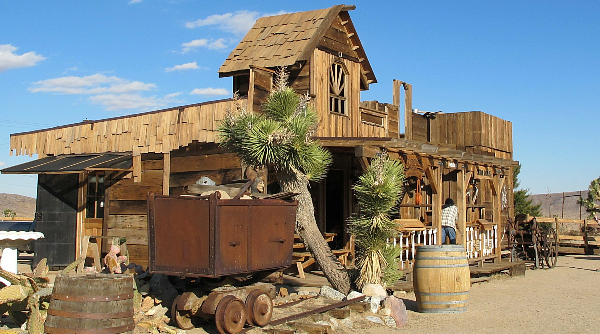Explore California’s boom-and-bust heritage as you visit deserted settlements, rusting railways, and abandoned mines. To see every destination on the list, prepare for a 3-6 day road trip that includes 9 stops over the course of 770 miles. Start at Shasta State Historic Park and end at Calico Ghost Town. Take a look at everything there is to explore on this trip through the Ghost Towns of California.
Shasta State Historic Park
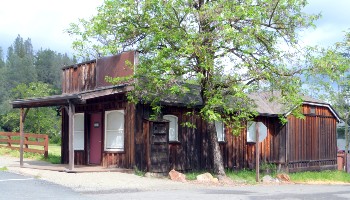 In the 1850s, Old Shasta was the queen city of California’s northern mining district. The town supported hotels, stores, and saloons in the largest row of brick buildings north of San Francisco. But when the Gold Rush on the north state’s rivers lost its gleam and the railroad was re-routed through the town of Poverty Flats (now Redding), Old Shasta’s residents departed for more promising regions, and the town faded into the history books. Tour the city’s crumbling remains at Shasta State Historic Park on Highway 299 west of Redding. Don’t miss the beautifully restored 1861 County Courthouse and its jail cells and gallows. The building is now a museum that showcases an Old West gun collection and mining memorabilia and tells the tales of the town’s fascinating history.
In the 1850s, Old Shasta was the queen city of California’s northern mining district. The town supported hotels, stores, and saloons in the largest row of brick buildings north of San Francisco. But when the Gold Rush on the north state’s rivers lost its gleam and the railroad was re-routed through the town of Poverty Flats (now Redding), Old Shasta’s residents departed for more promising regions, and the town faded into the history books. Tour the city’s crumbling remains at Shasta State Historic Park on Highway 299 west of Redding. Don’t miss the beautifully restored 1861 County Courthouse and its jail cells and gallows. The building is now a museum that showcases an Old West gun collection and mining memorabilia and tells the tales of the town’s fascinating history.
Malakoff Diggins State Historic Park
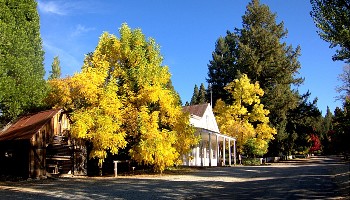 In the 1870s, hydraulic mining was hailed as the new revolution in the quest for gold—much faster and more powerful than digging by hand or machine. Powerful jets of water channeled through canvas hoses stripped the mountains of their soil to reveal underlying treasures. Northeast of Nevada City, the village of North Bloomfield sprung up to serve the new hydraulic mines in what would become the world’s richest mining district. But all that ended in 1884 when hydraulic mining was outlawed, and the mines closed down. At Malakoff Diggins State Historic Park, see the eroded hillsides, massive tailing piles, and 600-foot-deep canyon created by hydraulic mining, then stroll around a restored saloon, barbershop, general store, blacksmith shop, and former dance hall (now the park museum).
In the 1870s, hydraulic mining was hailed as the new revolution in the quest for gold—much faster and more powerful than digging by hand or machine. Powerful jets of water channeled through canvas hoses stripped the mountains of their soil to reveal underlying treasures. Northeast of Nevada City, the village of North Bloomfield sprung up to serve the new hydraulic mines in what would become the world’s richest mining district. But all that ended in 1884 when hydraulic mining was outlawed, and the mines closed down. At Malakoff Diggins State Historic Park, see the eroded hillsides, massive tailing piles, and 600-foot-deep canyon created by hydraulic mining, then stroll around a restored saloon, barbershop, general store, blacksmith shop, and former dance hall (now the park museum).
Empire Mine State Historic Park
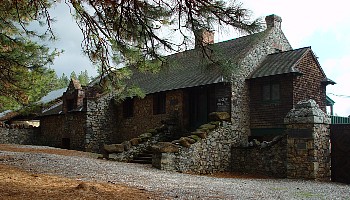 Get a one-two punch of experiences with a visit to Grass Valley’s remarkable Empire Mine State Historic Park. At the visitor center, learn about one of California’s oldest, largest, deepest, longest, and richest gold mines. In the course of a century, 5.6 million ounces/159 million grams of gold were mined. To get a sense of the size of the mine, see the scale model representing the mine’s 5-square-mile/13-square-km network, then walk outside to the entrance of the actual shaft—a tiny peek into a staggering underground maze of 367 miles/591 kilometers.
Get a one-two punch of experiences with a visit to Grass Valley’s remarkable Empire Mine State Historic Park. At the visitor center, learn about one of California’s oldest, largest, deepest, longest, and richest gold mines. In the course of a century, 5.6 million ounces/159 million grams of gold were mined. To get a sense of the size of the mine, see the scale model representing the mine’s 5-square-mile/13-square-km network, then walk outside to the entrance of the actual shaft—a tiny peek into a staggering underground maze of 367 miles/591 kilometers.
Shift gears—mentally and physically—with a tour of Bourn Cottage, a magnificent country estate, where no expense was spared to create a two-story stone citadel patterned after the noble estates of 19th century England, comes complete with redwood interiors, and leaded-glass windows.
Guided tours are offered from May through September.
Bodie State Historic Park
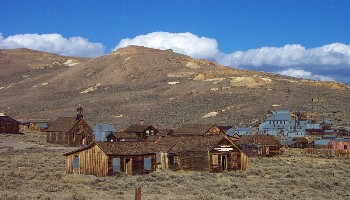 Just past the cattle-ranching town of Bridgeport, turn east onto the dusty desert road that winds into Bodie State Historic Park, once a booming mining community in the late 1800s. Over time, the townsfolk began to fade away with the gold, leaving the buildings alone and at the mercy of the dry desert winds. Walk the silent streets lined with shops, hotels, and simple homes, each one carefully preserved to look just as they did when the last of Bodie’s residents moved away. Look for period images on newspapers stuffed into the walls as makeshift insulation. Old trucks and gas pumps, a weathered wood church, and the lonely cemetery paint a picture of life—and death—in this remote corner of California’s high desert.
Just past the cattle-ranching town of Bridgeport, turn east onto the dusty desert road that winds into Bodie State Historic Park, once a booming mining community in the late 1800s. Over time, the townsfolk began to fade away with the gold, leaving the buildings alone and at the mercy of the dry desert winds. Walk the silent streets lined with shops, hotels, and simple homes, each one carefully preserved to look just as they did when the last of Bodie’s residents moved away. Look for period images on newspapers stuffed into the walls as makeshift insulation. Old trucks and gas pumps, a weathered wood church, and the lonely cemetery paint a picture of life—and death—in this remote corner of California’s high desert.
Be sure to bring food; there are no concessions in the park (though there is potable water). A bookstore is well stocked with interesting information, and the self-guided walking tour is wealth worth doing.
Ballarat Ghost Town
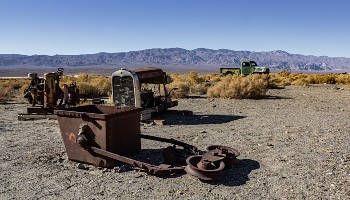 Death Valley’s mining history is captured in the adobe ruins and weathered wooden shacks at the lonely outpost of Ballarat (off Panamint Valley Road north of Trona). In 1898, the town’s population rose to around 500 after successful gold strikes in the Panamint Mountains. The burgeoning settlement soon had three hotels, seven saloons, a post office, and a Wells Fargo stop, but after two decades the miners’ luck ran out and the town emptied out.
Death Valley’s mining history is captured in the adobe ruins and weathered wooden shacks at the lonely outpost of Ballarat (off Panamint Valley Road north of Trona). In 1898, the town’s population rose to around 500 after successful gold strikes in the Panamint Mountains. The burgeoning settlement soon had three hotels, seven saloons, a post office, and a Wells Fargo stop, but after two decades the miners’ luck ran out and the town emptied out.
Today you’re likely to see more wild burros than people. But the desert scenery hasn’t diminished—a few remaining buildings are backed by the wildly rugged and steep Panamint Range, drawing photographers and history lovers.
Randsburg
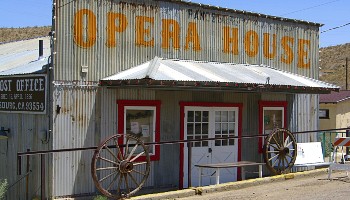 The living ghost town of Randsburg saw its heyday in the 1890s when gold, silver, and tungsten were discovered in the high-desert hills. In 1899, its population topped 3,500, but today it hovers around 70. Located south of Ridgecrest, this tiny town makes a lively stop amid the sprawling emptiness of the Mojave Desert. Order a root beer float from the General Store’s 1904 soda fountain and admire its embossed tin ceiling. Stop in and marvel at the Rand Desert Museum’s mining machinery. A handful of antique shops may or may not be open, but the White House Saloon is a dependable bet for a cold beer served up with a genuine dose of Old West charm.
The living ghost town of Randsburg saw its heyday in the 1890s when gold, silver, and tungsten were discovered in the high-desert hills. In 1899, its population topped 3,500, but today it hovers around 70. Located south of Ridgecrest, this tiny town makes a lively stop amid the sprawling emptiness of the Mojave Desert. Order a root beer float from the General Store’s 1904 soda fountain and admire its embossed tin ceiling. Stop in and marvel at the Rand Desert Museum’s mining machinery. A handful of antique shops may or may not be open, but the White House Saloon is a dependable bet for a cold beer served up with a genuine dose of Old West charm.
Barstow
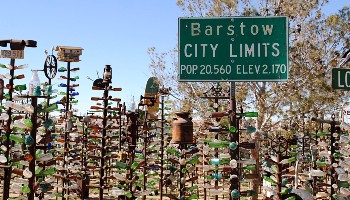 This remote desert town is the place to be for some of the best remnants from the migration west. Plus, there’s some good outlet shopping too. First up is the wacky storage closet of the region’s memorabilia, the Route 66 Mother Road Museum. Period road signs, photos, and other mid-century oddities take you down memory lane of the 20th-century pioneers searching for the California dream. Just west of Barstow is the eccentric but oddly beautiful Elmer Long’s Bottle Tree Ranch, the work of a local artist, with welded metal “trees” festooned with discarded bottles, vintage toys, and other scraps. It’s a colorful example of the region’s still-strong folk art tradition.
This remote desert town is the place to be for some of the best remnants from the migration west. Plus, there’s some good outlet shopping too. First up is the wacky storage closet of the region’s memorabilia, the Route 66 Mother Road Museum. Period road signs, photos, and other mid-century oddities take you down memory lane of the 20th-century pioneers searching for the California dream. Just west of Barstow is the eccentric but oddly beautiful Elmer Long’s Bottle Tree Ranch, the work of a local artist, with welded metal “trees” festooned with discarded bottles, vintage toys, and other scraps. It’s a colorful example of the region’s still-strong folk art tradition.
For more ideas on what to do in the area, visit the California Welcome Center, in the Outlets at Barstow, where you can hunt for bargains on favorite labels and name brands, including Calvin Klein, Skechers, and Michael Kors.
Calico Ghost Town
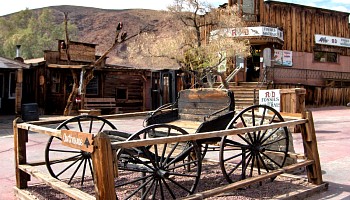 Calico, the site of California’s largest silver strike and home to 500 mines, is now a ghost town theme park with attractions that include the Calico Odessa Railroad and the Calico Mystery Shack, filled with “amazing feats and confusing sights.” Fill a day panning for gold, riding the rails, browsing the shops, and knocking back sarsaparillas at Lil’s Saloon (mosey in through the swinging wooden doors).
Calico, the site of California’s largest silver strike and home to 500 mines, is now a ghost town theme park with attractions that include the Calico Odessa Railroad and the Calico Mystery Shack, filled with “amazing feats and confusing sights.” Fill a day panning for gold, riding the rails, browsing the shops, and knocking back sarsaparillas at Lil’s Saloon (mosey in through the swinging wooden doors).
On Saturday nights, you might be able to make contact with Calico’s ghosts on a tour through the spooky darkness of the 1880s Maggie Mine.
Source: Visit California
Photo Credits:
Lead via Pixabay
Shasta State Historic Park via Wikimedia Commons by Ian Poellet License CC Attribution ShareAlike 4.0 International
Malakoff Diggins State Historic Park via Wikimedia Commons by jcookfisher License CC Attribution 20.0 Generic
Empire Mine State Historic Park via Wikimedia Commons by Jane Pojawa License CC ShareAlike 3.0 Unported
Bodie State Historic Park via Pixabay
Ballarat Ghost Town via Flickr by David Seibold License CC Non-Commercial 2.0 Generic
Randsburg via Wikipedia by Pretzelpaws License CC Attribution ShareAlike 3.0 Unported
Barstow via Pixabay
Calico Ghost Town via Go GlobeHopper


